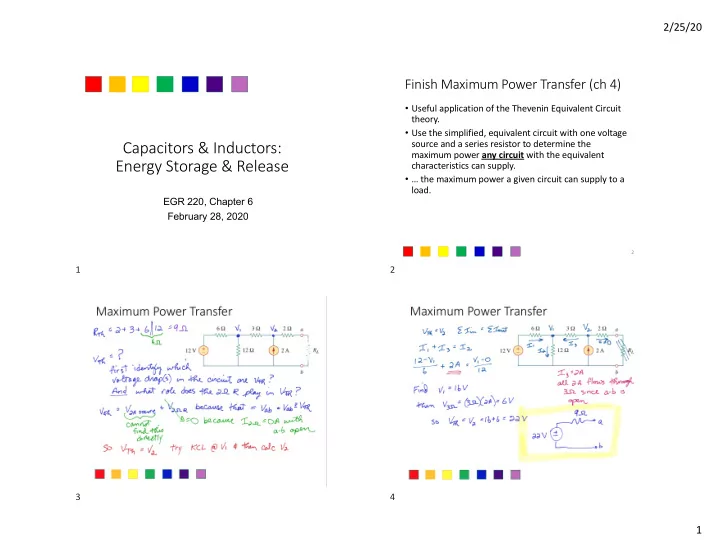

2/25/20 Finish Maximum Power Transfer (ch 4) • Useful application of the Thevenin Equivalent Circuit theory. • Use the simplified, equivalent circuit with one voltage Capacitors & Inductors: source and a series resistor to determine the maximum power any circuit with the equivalent Energy Storage & Release characteristics can supply. • … the maximum power a given circuit can supply to a load. EGR 220, Chapter 6 February 28, 2020 2 1 2 3 4 3 4 1
2/25/20 Maximum Power Transfer Overview: Energy Storage Elements • Our questions of understanding: • V; I; conservation laws • Energy storage and dynamics • Transient behavior & time constant • Steady-state behavior • Introduction to capacitors • Matter can store electric charge • Create and support an electric field, E • Introduction to inductors • Matter responds to moving charge (current) by inducing a voltage drop • Create and support a magnetic field, B 5 6 5 6 Heating/Cooling a Room à Time Filling a Bucket with Water à Time 7 8 7 8 2
2/25/20 Natural Response + Steady-State of Natural Response à Charge & Discharge Dynamic Circuits • No initial stored energy, charging • Initial stored energy, discharging • Initial stored energy, charging 9 10 9 10 Natural Response + Steady-State of Natural Response + Steady-State of Dynamic Circuits Dynamic Circuits • No initial stored energy, charging • No initial stored energy, charging • Initial stored energy, discharging • Initial stored energy, discharging • Initial stored energy, charging • Initial stored energy, charging 11 12 11 12 3
̇ 2/25/20 Capacitors and Stored E E à Voltage Capacitors and Stored E E à Voltage 𝑅 = 𝑒𝑅 𝑒𝑢 = 𝑗 = 𝐷 𝑒𝑊 # ' # ' 𝐷~ $ & 𝐷 = 𝐷~ $ & 𝐷 = ➢ 𝑅 = 𝐷𝑊 ➢ ( ( 𝑒𝑢 13 14 13 14 * Capacitors * Capacitors and E -field • Charge is stored How ? Where ? • Expression: q = _________ $ • V-I relationship: = i c = $ • Restrictions on the voltage across a capacitor? • Think about calculus and taking a derivative • What is the steady-state behavior? 15 16 15 16 4
2/25/20 Equivalent Capacitance The ‘Constituent Relations’ for R, C and L • Property of ‘capacitance’ C = εA / d • ( i.e ., What is the V-I relationship?) • If plate area, A, increases, what happens to the • R: V R = ___________; I R = ____________ capacitance? • C: V c = ___________; I c = ____________ • If the distance between the plates, d, increases, what happens to capacitance? • L: V L = ___________; I L = ____________ (the dual of the expression for C) 17 18 17 18 Capacitors in Series: C eq =? Capacitors in Parallel: C eq =? C = εA / d C = εA / d 19 20 19 20 5
2/25/20 Inductors and Stored B Inductors and Stored B 21 22 21 22 * Inductance * Equivalent Inductance • How is energy stored? • Property of inductance – experimental observation: • A changing current (not a constant DC value)… • “induces” a _____________________ • V-I expression v L = • What are the restrictions on the current flowing through an inductor? • Think about calculus again • What is the steady-state behavior? 24 25 24 25 6
2/25/20 Series Inductors: L eq ? Equivalent Inductance 26 27 26 27 Parallel Inductors: L eq ? Natural Response + Steady-State of Dynamic Circuits No initial stored energy, charging Initial stored energy, discharging 28 29 28 29 7
2/25/20 Next Lab: Explore “ time constant ” Next Lab: Explore “ time constant ” 𝛖 R S V S R R C C 𝜐 = 𝑆𝐷 (Measured in seconds) 30 31 30 31 * Chapter 6 Recap * Capacitor & Inductor Concepts • Capacitors and inductors, * table 6.1 * • Know the v-i relationship for • Resistors • Definition and properties • Inductors • Circuit analysis: v-i relationship • Capacitors • Series and parallel combinations • Know the expressions for series and parallel • Form of v and i are exponential (more in chapter 7) • Resistors • When behavior is as a short or open circuit • Inductors • Physical, conservation laws • Capacitors • Know whether instantaneous changes in voltage and current are allowed or are impossible across/through elements 32 33 32 33 8
2/25/20 Questions? 34 9
Recommend
More recommend